The Bayraktar Kızılelma, also known as Red Apple in English, is a jet-powered unmanned combat aerial vehicle (UCAV) that is currently under development by the Turkish defence company Baykar. Known for producing the Bayraktar line of drones used both in Ukraine and across conflict zones all over the world, the company has developed this advanced fighter jet as part of Project MIUS (Muharip İnsansız Uçak Sistemi, which translates as Combatant Unmanned Aircraft System). Expected to be introduced into active service with the Turkish Air Force in 2025, this advanced UCAV jet’s fielding will also represent the first time an active service military deploys an unmanned fighter jet alongside its forces in operations.
Images Sourced From: War Wings Daily, Baykar Technology, Defence Turk,
1 Development History of the Bayraktar Kızılelma
1.1 Initial studies and First Public Announcement of the Bayraktar Kızılelma
The first studies regarding the production and development of the Bayraktar Kızılelma were initiated in 2013. However, the first design images and information regarding the characteristics and capabilities of the UCAV fighter jet were only released in July 2021. [source]
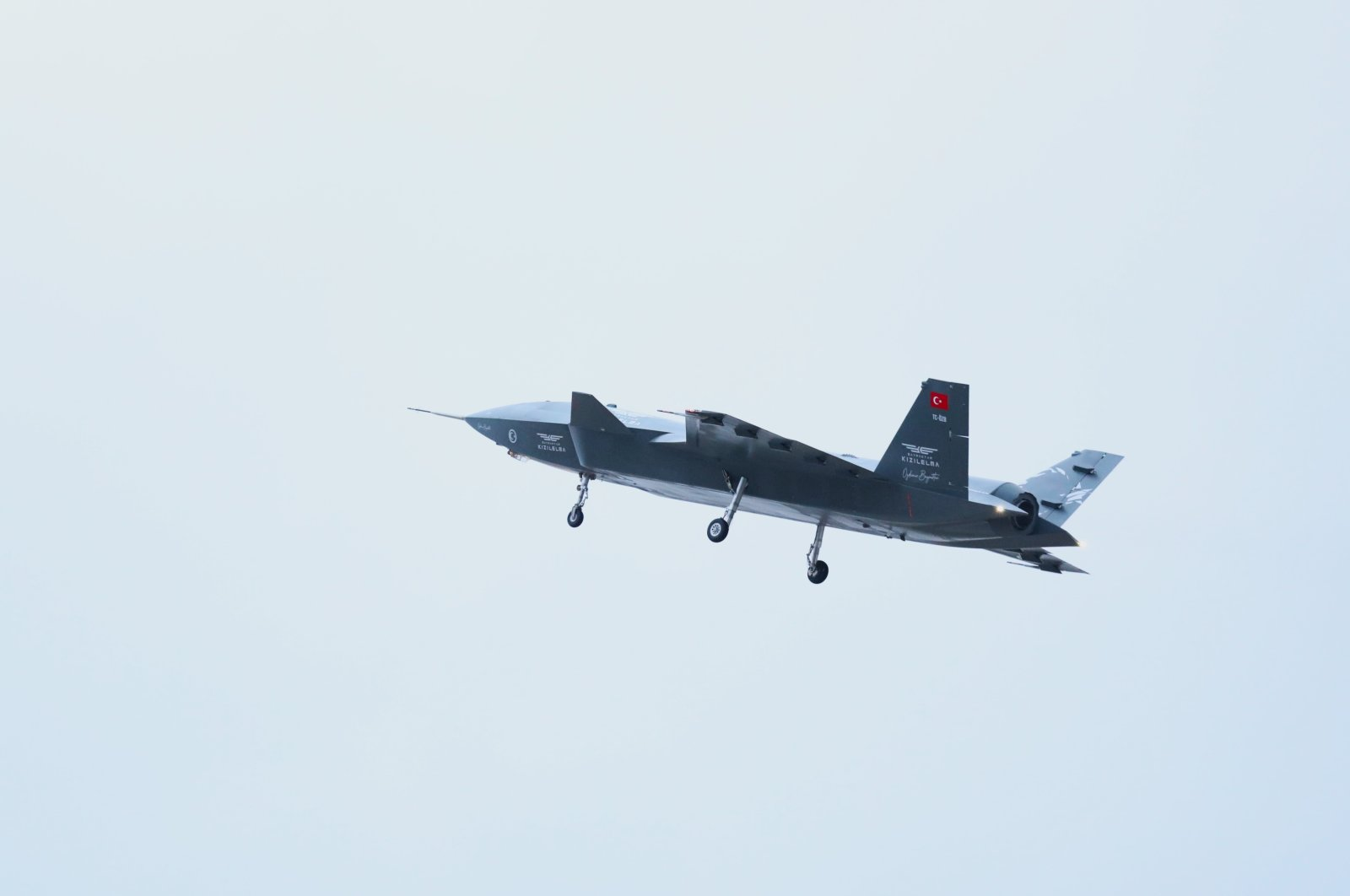
1.2 Engine Selection For Project MIUS
Shortly after the first design images were released regarding Project MIUS and the development of the UCAV jet, Baykar signed the AI-322 Turbofan Engine Supply Agreement with the Ukrainian company Ivchenko-Progress. This contract, signed at the SAHA EXPO Defence and Aviation Hybrid Fair in Istanbul, ensured that Ivchenko-Progress would supply Baykar with the AI-25TLT jet engines for Baykar to use in Project MIUS. [source]
1.3 Disclosure of Kızılelma and Start of Prototype Production
Although the project was initially known as MIUS (Muharip İnsansız Uçak Sistemi – Combatant Unmanned Aircraft System), the official name of the UCAV, Kızılelma (Red Apple), was made public in March 2022.
At the same time as the disclosure of the Kızılelma name, it was announced that the prototype of the jet had already entered production. The first active prototype variant of the Kızılelma was displayed in 2022 at the Teknofest Aerospace and Technology Festival, aka Teknofest, the world’s largest aviation and aerospace technology festival, which is held annually in Turkey. [source, source]
1.4 Testing Process of the Bayraktar Kızılelma
Following the public display of the unmanned fighter jet prototype, it underwent a 9-month testing that involved 12 test flights. This process went as follows:
- 19 September 2022: First engine integration test successfully conducted. [source]
- 20 November 2022: Initial automatic taxiing and ground running tests were carried out. [source]
- 3 December 2022: First take-off test flights and also the first instance of the Kızılelma leaving the ground. [source]
- 14 December 2022: First test flight. [source]
- Mid-January 2023: Second test flight. [source]
- 15 April 2023: Fourth test flight. [source]
- 18 April 2023: First test flight, which involved landing gear being folded inside the fuselage of the vehicle.
- 19 April 2023: Sixth and seventh test flights with both serial landing-take-off and high-speed flight trials being conducted. [source]
- 20 April 2023: Eighth test flight with both high-speed flight and manoeuvre trials being held alongside serial landing-take-off trials, which it passed. [source]
- 30 April 2023: The Kızılelma UCAV flew in formation with a Turkish Air Force F-16C during the TEKNOFEST event held in Istanbul. [source]
- 17 June 2023: The Kızılelma UCAV reached an altitude of 9.5km (5.9 Miles) during its 12th test flight. [source]
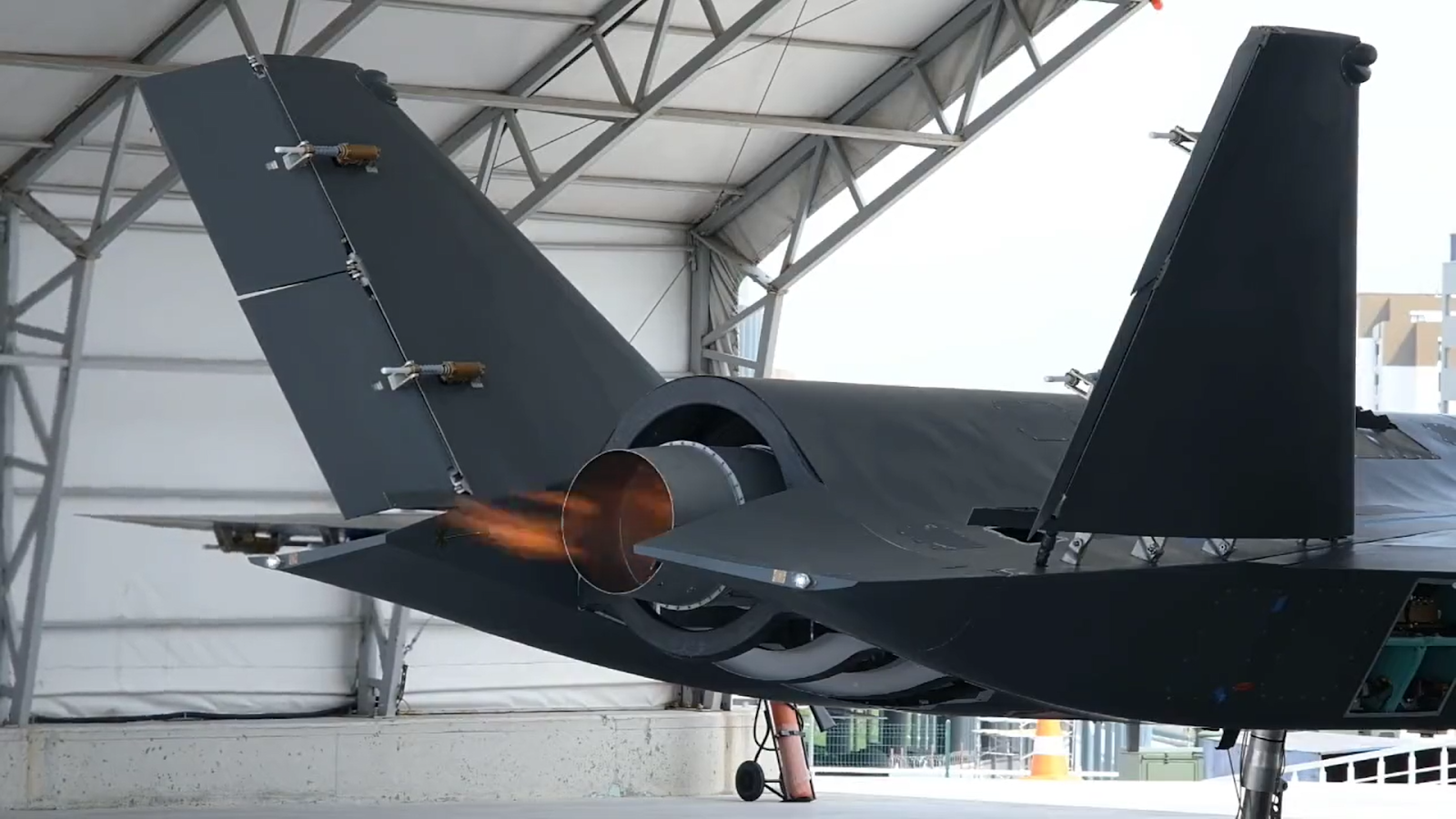
2 Features of the Bayraktar Kızılelma
The Bayraktar Kızılelma’s core features (some of which may change due to planned variants – see variants section below) are as follows:
2.1 Airframe
The Kızılelma is unmanned and features a low radar cross section (RCS), carbon fibre, supersonic airframe that is also equipped with an AESA radar. Powered by a turbofan engine, which is fed by two air inlets, control of the aircraft in flight is achieved with two vertical stabilisers.
Coupled canard controls allow for either increased manoeuvrability or better control of the main wing airflow. Internal components (including weapons bays located underneath the aircraft) will allow the UCAV to operate inside of contested airspaces whilst sustaining low observability.
Measuring approximately 14.7 metres (48.2 feet) in length, it also has a wingspan of 10 metres (32.8 feet). The dimensions of the Kızılelma also allow it to be compact enough to enable carrier-based operations. [source, source, source, source]
2.1.1 Low-detection Radar Signature Features
Several design elements of the platform reduce its detectability by radar. For example, its low-RCS airframe will allow the Bayraktar Kızılelma to go undetected for a longer period than a conventional non-stealth aircraft. Further dampening its radar signature are special design elements, such as having few protruding surfaces that reflect radar energy; for example, it has little to no visible rivets and an internal weapons bay. Also, the Kızılelma is primarily composed of carbon fibre components, which both reduce the weight of the aircraft and improve radar absorption. Radar-absorbent materials (RAMs) are also integrated into the coating on the Kızılelma. [source]
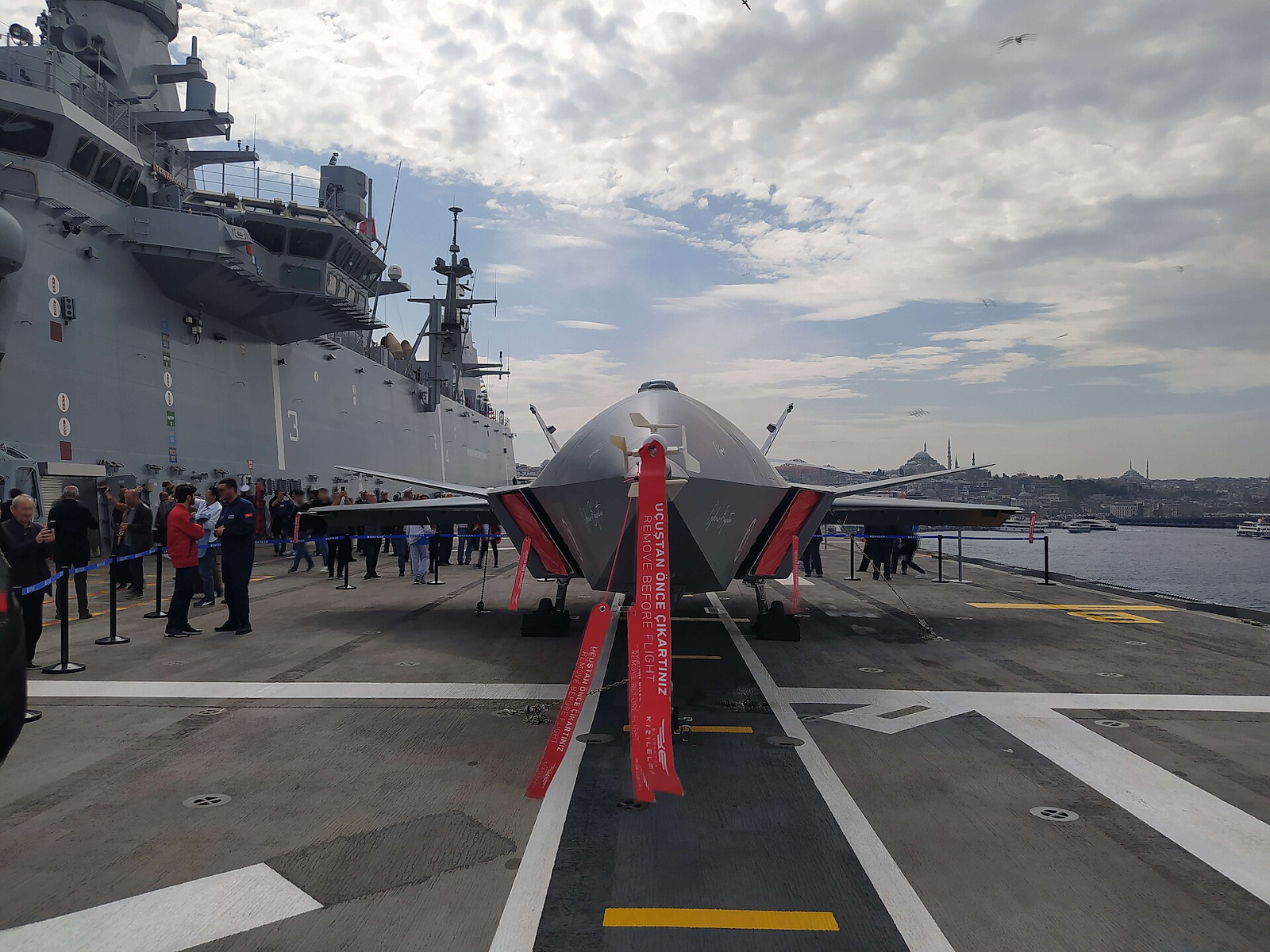
2.1.2 AESA radar system
An AESA (active electronically scanned array) radar system is a type of phased array antenna. It is computer-controlled, which means that the beam of radio waves emitted by the radar system can be electronically steered to point in different directions, this is also all done without moving the antenna.
The AESA array is a more advanced system than its predecessor, the PESA. The AESA can radiate multiple beams of radio waves, whereas the PESA can only emit a single beam of radio waves at one time.
The Bayraktar Kızılelma is most likely being produced with the MURAD-200A AESA radar onboard. There are early reports that the MURAD-200A is integrated into the Akinci and other projects, such as the KAAN, Hurjet and Anka-3, all under development or in production. [source]
2.1.3 Avionics and Flight Control
The Kızılelma is also equipped with an advanced fly-by-wire control system, which is optimised for high-G manoeuvres. This enables superior agility in both air-to-air and air-to-ground operations.
In contrast to other, more traditional drones, which rely on satellites for control, the Kızılelma incorporates AI-based autonomy, which allows for independent combat decision-making and mission execution. [source]
2.1.4 Canards
The Bayraktar Kızılelma also features a canard delta wing configuration, which means that there is a smaller forewing in front of the main triangular-shaped delta wing. This has been seen on other next-generation stealth aircraft, such as the Chinese Chengdu J-20. The canards reduce stealth–they provide another surface for radar to detect–but increase manoeuvrability. [source]
2.1.5 Takeoff weight
The Bayraktar Kızılelma features a maximum takeoff weight of 6000 kg (13200 lbs). Of this, 1500 kg is available to be used for the payload and weapons systems. [source]
2.1.6 Propulsion System
The Kızılelma’s initial prototype variant is equipped with a singular Ivchenko-Progress AI-25TLT turbofan engine. It is a dry thrust engine that is optimised for subsonic operations. However, as mentioned previously, future variants of the aircraft will integrate the more advanced and more powerful Ivchenko-Progress AI-322F. They may also potentially use the Turkish TEI-TF6000 engine. Both of these engines feature afterburner capabilities and enable supersonic speeds.
The intake design featured on the Kızılelma follows a single dorsal air intake layout, which reduces both infrared and radar signatures. The exhaust nozzle on the Kızılelma is designed for low observability, which also minimises heat signatures and the susceptibility to infrared-guided missiles. [source]
2.1.7 Landing Gear
The Kızılelma is taildragger-configured. This feature of the aircraft means that it has reinforced landing gear, which can accommodate short takeoff and landing (STOL) operations on aircraft carriers. It is also equipped with an arrestor hook, which allows for short-field recovery without requiring catapult-assisted takeoff seen on 4th and 5th generation carrier-enabled aircraft. [source]
Autonomous Landing
The Kızılelma is also designed to be able to autonomously land on aircraft carriers. It incorporates precise GPS systems, advanced inertial navigation systems (INS), and also optical landing aids, which enable accurate deck landings.
These features allow the Kızılelma to operate from shorter runways, primarily carriers, but it also allows the deployment of the aircraft from expeditionary (temporary) airstrips within conflict zones. [source]
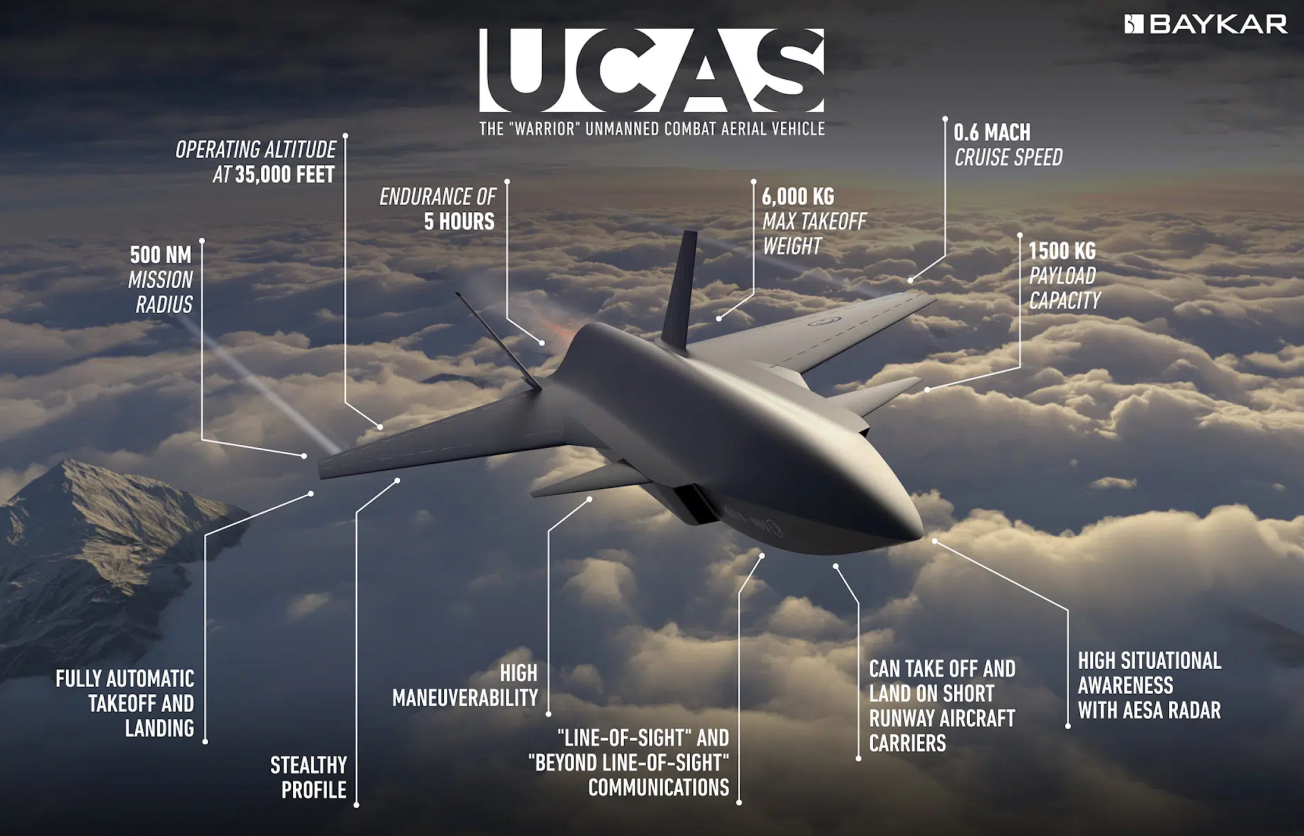
3 Variants of the Bayraktar Kızılelma
At Teknofest 2022, Barykar–the company producing the Bayraktar Kızılelma for the Turkish Armed Forces–announced that there are at least 3 planned variants of the Kızılelma. Baykar also announced that the engines for the variants of the platform will be produced by the joint Turkish-Ukrainian venture Black Sea Shield. [source, source]
There are three planned variants of the Kızılelma:
3.1 Kızılelma-A
- Basic Performance Statistics
- 1.5 Tons Payload Capacity
- 8.5 Tons Maximum Take-Off Weight
- 0.6 Mach Cruise Speed
- 0.9 Mach Max Speed
- 500 nm Combat Radius
- 25.000 Feet Operational Altitude
- 3+ Hours Endurance
- Advanced Features
- Low RCS
- High Maneuverability
- Features both take off and landing capability from Short-Runway Aircraft Carriers
- High Situational Awareness with AESA Radar
[source]
3.2 Kızılelma-B
- Upgraded with an AI-322F turbofan which also features afterburning capabilities
- Maximum speed: Mach 1.2 (1470 km/h – 914 mph).
- Also features an increased payload capacity: 1800 kg (4000 lb).
- This is on top of the already 6000 kg (13,200 lb) payload capacity mentioned above.
- Enhanced avionics, sensor fusion, and also features AI-assisted target engagement.
[source]
3.3 Kızılelma-C
- Advanced variant which also features a twin-engine configuration (Potentially the future TEI-TF6000).
- Maximum speed exceeds Mach 1.4 (1728km/h – 1074 mph).
- Extended range – 2200km (1367 miles).
- Both a heavier payload capacity and an expanded internal weapons bay.
- Designed for both air superiority and electronic warfare missions.
[source]
3.4 Potential For Export
Ankara plans to allow the export of the Bayraktar Kızılelma to allied countries that are interested in purchasing a 5th-generation platform, ostensibly levelling the playing field against enemy nations that may have held both a technological and numerical advantage. Potential buyers of the Kızılelma include Azerbaijan, Pakistan, and, additionally, other Middle Eastern nations. [source]
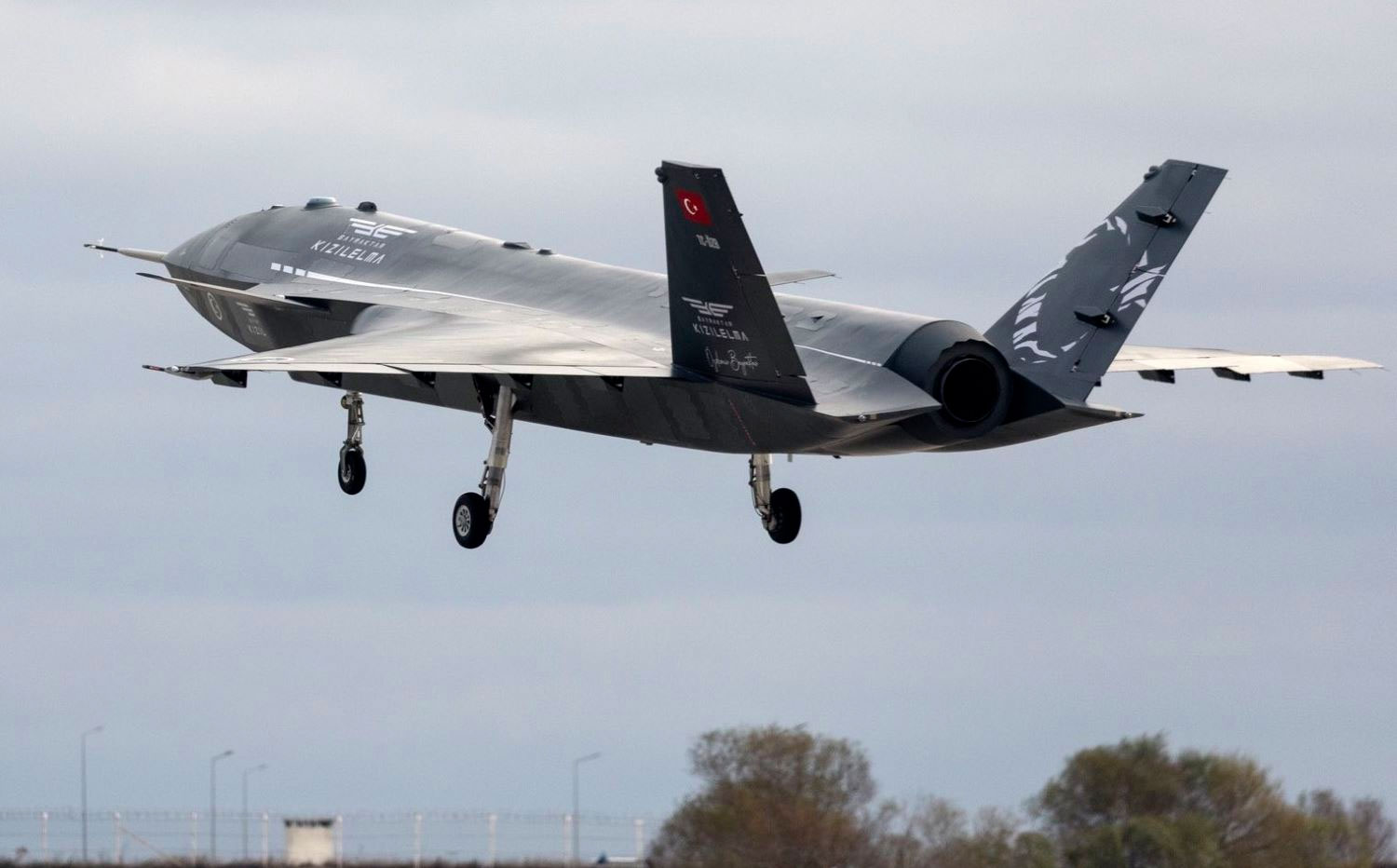
4 Armament
The design of the Bayraktar Kızılelma allows it to utilise internal and external weapon bays. This includes:
- Hardpoints:
- 2x internal weapon stations
- 6x external stations
4.1 Non-Precision Guided Munitions
The weapon bays also allow the platform to carry a wide variety of offensive and defensive weaponry. Turkey’s expansive weapons program has produced several air-to-air and air-to-ground munitions that are potential candidates for use on the Kızılelma, including:
- Air-to-Air Missiles (AAMs):
- TÜBİTAK SAGE Bozdoğan IIR-guided AAM – 30km range
- TÜBİTAK SAGE Gökdoğan BVRAAM – 100km range
- TÜBİTAK SAGE Gökhan Ramjet BVRAAM
- Anti-Radiation Missiles (ARMs)
- Roketsan Akbaba
- (Anti-Ship) Cruise Missiles
- TÜBİTAK SAGE SOM-A – 275+ km range (Uses GPS/INS guidance)
- HE fragmentation for use against stationary targets
- TÜBİTAK SAGE SOM-B1 – 275+ km (Uses GPS/INS/IIR guidance)
- HE fragmentation warhead for use against stationary targets
- TÜBİTAK SAGE SOM-B2 – 275+ km (Uses GPS/INS/IIR guidance)
- Tandem penetration warhead for use against hardened targets
- TÜBİTAK SAGE SOM-C1 – 275+ km (Uses GPS/INS/IIR guidance and datalink)
- HE fragmentation warhead for use against mobile targets
- TÜBİTAK SAGE SOM-C2 – 275+ km (Uses GPS/INS/IIR guidance and datalink)
- Tandem penetration warhead for use against mobile hardened targets
- TÜBİTAK SAGE SOM-J – 275+ km (Uses GPS/INS/IIR guidance and datalink)
- Semi-armour-piercing warhead for use against naval vessels
- TÜBİTAK SAGE SOM-A – 275+ km range (Uses GPS/INS guidance)
- Loitering Munitions
- STM ALPAGU – ~10km range
- Roketsan ALPAGUT – ~60km range
[source]
4.2 Precision Guided Munitions (PGMs)
The Bayraktar Kızılelma can also carry a wide variety of precision-guided munitions (PGMs), including:
- Aselsan LGK-82 – 12+km (Laser guidance integrated on a Turkish-produced Mk.82 bomb)
- Aselsan LGK-84 – 12+km (Laser guidance integrated on a Turkish-produced Mk.84 bomb)
- Roketsan Teber-81 – 28km (GPS/INS/Laser guidance integrated on a Turkish-produced Mk.81 bomb)
- Roketsan Teber-82 – 28km (GPS/INS/Laser guidance integrated on a Turkish-produced Mk.82 bomb)
- Roketsan Laçin – 28km (GPS/INS/IIR guidance and datalink integrated on a Turkish-produced Mk.82)
- TÜBİTAK SAGE GÖZDE – 28km (GPS/INS/Laser guidance integrated on a Turkish-produced Mk.82)
- TÜBİTAK SAGE GÖKÇE – 28km (GPS/INS/Laser guidance integrated on a Turkish-produced Mk.83)
- TÜBİTAK SAGE HGK-82 – 28km (GPS/INS guidance integrated on a Turkish-produced Mk.82 bomb)
- TÜBİTAK SAGE HGK-83 – 28km (GPS/INS guidance integrated on a Turkish-produced Mk.83 bomb)
- TÜBİTAK SAGE HGK-84 – 28km (GPS/INS guidance integrated on a Turkish-produced Mk.84 bomb)
- TÜBİTAK SAGE LHGK-84 – 28km (GPS/INS/Laser guidance integrated on a Turkish-produced Mk.84)
- TÜBİTAK SAGE Kuzgun-SS – 40+km (Uses INS/GPS/Laser/IIR/CCD-mmW radar guidance and datalink)
- Roketsan MAM-T – 80+ km (Uses GPS/INS/Laser guidance)
- Aselsan MİNBO Small Diameter Bomb – 100km (Uses GPS/INS guidance)
- Aselsan IIR Small Diameter Bomb – 100km (Uses infrared imaging guidance)
- TÜBİTAK SAGE KGK-82 – 110km (GPS/INS and wing guidance integrated on a Turkish-produced Mk.82 bomb)
- TÜBİTAK SAGE KGK-SİHA-82 – 110km (GPS/INS/Laser and wing guidance integrated on a Turkish-produced Mk.82 bomb)
- TÜBİTAK SAGE KGK-83 – 110km (GPS/INS and wing guidance integrated on a Turkish-produced Mk.83 bomb)
- TÜBİTAK SAGE KGK-84 – 100km (GPS/INS and wing guidance integrated on a Turkish-produced Mk.84 bomb)
[source]

4.2.1 Other PGMs
The Bayraktar Kızılelma can also carry other precision-guided munitions (PGMs), including:
- Precision-Guided Bunker Busters
- TÜBİTAK SAGE SERT-82 – 28km (Turkish-produced Mk.82 penetrator bomb fitted with a GPS/INS guidance)
- TÜBİTAK SAGE SARB-83 – 28km (Turkish-produced Mk.83 penetrator bomb fitted with a GPS/INS guidance)
- TÜBİTAK SAGE SARB-83T – 28km (Turkish-produced Mk.83 thermobaric penetrator bomb fitted with a laser guidance)
- TÜBİTAK SAGE NEB-84 – 28km (Turkish-produced Mk.84 penetrator bomb fitted with a GPS/INS guidance)
- TÜBİTAK SAGE NEB-84T – 28km (Turkish-produced Mk.84 thermobaric penetrator bomb fitted with a GPS/INS guidance)
- Precision-Guided Air-To-Surface Missiles (ASMs)
- TÜBİTAK SAGE Kuzgun-KY – 40+ km (Uses INS/GPS/Laser/IIR/CCD-mmW radar guidance and datalink)
- TÜBİTAK SAGE Kuzgun-TJ – 180+ km (Uses INS/GPS/Laser/IIR/CCD-mmW radar guidance and datalink)
[source]
4 Mission Profile of the Bayraktar Kızılelma
The Bayraktar Kızılelma is equipped and enabled to undertake both a variety of missions and types of operations. This includes:
- Air Superiority Missions
- AESA radar enables the detection of both enemy aircraft and drones at long ranges
- Autonomous AI enables high-speed intercepts in dogfighting
- Stealth capability allows for ambush tactics against other aircraft
- Strategic Strike Missions
- Deep strike operations against high-value enemy assets, and additionally, enemy positions
- Cruise missile deployment against precise targets
- Penetration of contested airspaces using low-observable technology
- Carrier-Based Maritime Operations
- Designed to operate from the TCG Anadolu, one of the Turkish Navy’s amphibious assault ships
- Can conduct maritime patrols, anti-ship strikes and also fleet defence
- Electronic Warfare (EW) & also the Suppression of Enemy Air Defences (SEAD)
- The Bayraktar Kızılelma is equipped with electronic jamming pods, which can disrupt both enemy radar and enemy missiles
- Can also suppress enemy SAM sites using the aforementioned anti-radiation missiles
[source]
5 Conclusion
The Bayraktar Kızılelma is a jet-powered unmanned combat aerial vehicle (UCAV), which is currently being developed by the Turkish defence company Baykar. Expected to be introduced into active service in 2025, the fielding of this highly advanced, AI-enabled UCAV jet will also represent the first time an active service military will deploy an unmanned fighter alongside its forces in operations. With the potential for export to international partners, the Bayraktar Kızılelma is certain to enable the rapid proliferation of unmanned weapons systems into conflict zones all over the globe.